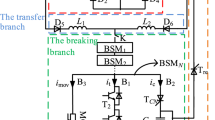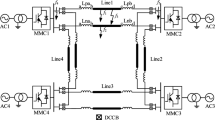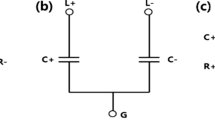Abstract
In this paper, we make an identification comparison of the common mode impedance of a DC grid consisting of a single converter, this identification between two types of grounding systems widely is used in the industrial sector. The study shows the impact of the earthing arrangement on the identification models, in normal operation, and under an electrical fault, knowing that the sizing of the filters is based on the knowledge of these impedances. We validated the results with Pspice in a frequency range up to 30 MHz; this work provides analytical models for predicting the effect of common mode interference in a DC network at the operating phase.
Access provided by Autonomous University of Puebla. Download conference paper PDF
Similar content being viewed by others
Keywords
1 Introduction
The evolution of the renewable energy reveals electrical microgrids with direct current used in the industrial and domestic distribution that is being connected to the main energy network or which are autonomous networks [1]. The efficiency of these DC networks has presented them as an optimal choice in the distribution of electrical energy, and research has a primary goal of making DC networks similar to those of the AC network, regarding techniques and applications [2,3,4,5]. Any electrical installation must meet requirements such as the safety of people and equipment, the quality of energy to provide and continuity of service with efficiency and reliability and as main axes the two types DC and AC share as examples the systems of earthing and protection [6].
The study of pole-to-pole (PP) or pole-to-pole (PG) faults is the major concern of engineering to prevent, predict and protect installations and guarantee continuity of service [7, 8]. And between the quality and efficiency that is achieved by the integration of load power electronics on the distribution networks are connected via power converters [9], these loads are nonlinear and with the activity of power electronics switching generating noise sources in the form of harmonics and other electrical and electromagnetic noises which interfere with the electrical installation and reduce its quality and even interrupt their operation and cause material damage [10, 11].
Acquired efficiency by the progress of power electronics puts us in confrontation with another challenge requires studies that identify sources of disturbance in DC networks, many studies focus on electromagnetic interference but the majority ignores the influence of the diversity of earthing systems on electronic systems and, in general, these studies are limited to the design phase when the neutral is connected to ground.
This work combines two axes, the System Earthing Arrangements (SEA), and the identification of disturbance sources in a DC network. In [12] Fault Detection, DC, Power Systems Based on Impedance Characteristics of Modules. The identification of impedances is of great importance in filter optimization, and also provides a better understanding of the disturbance and current propagation paths. In differential mode, the pole (+) (−) conductors are the propagation path, and the protection wire (PE), chassis, and metals are common mode propagation paths through stray capacitances. The above is just in a normal operating mode, but the occurrence of an insulation fault changes the system behavior and creates new paths, which requires in-depth identification to have an early prediction for the design phase and also engineering after design in the implementation of devices in networks. Electrical installation to react under a fault of electrical insulation according to the (SEA), this work will concentrate on two types of earthing IT (Unearthed (or impedance-earthed)) and TN (Exposed-conductive parts connected to neutral) [1].
This study organized in:
Firstly, section focuses on the identification of the common-mode impedance of normal function [13, 14]. Secondly gives an idea of the influence of malfunction of a converter on according to (SEA). This malfunction is simulated by a short-circuit (insulation defect) between one of the conductors (L-N) and the ground (chassis). Behavioral models are developed in and are based on generic electrical systems given by passive components associated with voltage or current sources [15]. This study offers the Engineer a prediction of electromagnetic disturbance by mathematical models which allows better optimization of the filters of the DC network [18] or in the protection system. More than provides an idea of electromagnetic interference (EMI) in the event of insulation defects for two types of (SEA).
2 General Consideration
2.1 Common Mode Impedance
The DM and CM signals (currents and voltages) are expressed in terms of input signals (currents and voltages) of the model shown in Fig. 2. The structure of the converter can be represented by a generic quadruple (see Fig. 1(a)) [14].
Electrical diagram of a buck converter (a) in (DM/CM) basis, (b) in DM basis with decoupling, and (c) in CM basis with decoupling mode [14]
According to Fig. 1(a), the DM and CM signals can be expressed as follows:
Thus, the DM and CM impedances are, respectively, given by (4), and (5) according to the impedance of the circuit in Fig. 1(a).
The matrix [Z] has some non-diagonal terms (Z12 and Z21) corresponding to the coupling DM and CM. It should be noted that they are equal. For the case of the symmetrical system Z1 = Z2, the coupling terms become zero: Z12 = Z21 = 0. This results in a perfect decoupling between DM and CM. In this case, the electrical representation of the system becomes as shown in Fig. 2(b) and (c), and this approach will follow in this work according to:
The selected topology is a model structure of Buck converters sees Fig. 2.
In Fig. 2:
-
PE: Wire protection.
-
P: The plus.
-
N: The minus.
-
RN: (Resistance connected minuses to the ground).
2.2 TN Earthing System
The system is characterized by the direct neutral to ground point connection all the masses bonded to the PE protection wire. In a DC system called (−V) neutral and (+V) phase. Protection is reacted by overload. In our case eliminates RN (liaison resistance to the earth), see Fig. 2.
2.3 IT Earthing System
In the IT system ((Unearthed (or impedance-earthed)) the ground point at two possibilities, it is separately neutral or is connected by an important resistance value (RN). The protection is reacted only to the second insulation fault (PG). The first defect modifies the IT regime in TN, but the device remains in function. The installation is endowed with a permanent isolation controller.
3 Computing of a Common Mode (MC)
The identification of common mode impedances by the injection of small signals, we simulate sources of pole/ground voltages approach of the study and as follows (Fig. 3):
- Identification of the converter in normal operation in two systems TN and IT and another study under insulation fault similar to the previous one see Figs. 5 and 6.
3.1 Identification of MC in Normal Function
Figure 5 shows a buck converter under test for impedance indemnification in common mode. The Cpg, Cng, Cm represent the parasitic capacitances between neutral/chassis (G), phase/chassis (G) and the floating capacity according to the state of the switch in our case the (MOSFET).
The formula (8) represents the impedance of the converter in two modes: the online mode and the offline mode. The parallelism of the parasitic capacitors is in series with half the impedance of the filter. The addition of the resistance Rn depends on the neutral regime if the regime is TI Rn is a significant value otherwise it is zero.
The impedance Zm is dependent on the state of the switch see function (10) (Fig. 4).
3.2 Identification (MC) Under Insulation Fault
In this phase of the study, the behavior of the converter will be observed under a lack of isolation compared to the regime of the earth. Knowing that in the IT regime the protection of this reacts except that the second fault. Figure 7 shows the location of the two presumed defects.
4 PSpice Validation
The circuit is given in Fig. 1 is simulated by PSpice. Converter components such as inductances capacitors and even the load are also characterized by Impedance Analyzer (Agilent 4294A) to introduce parasitical elements on the simulated circuit. An AC-source \( v_{p} (t) \) is introduced to inject frequencies point by point from few Hertz up to 100 MHz (Fig. 1). The DM impedance \( Z_{DM} \) is performed for each injected frequency as given by (1). Simulation parameters are given below (Fig. 8):
-
Switching frequency \( f_{sw} \) = 10 kHz,
-
Duty cycle α = 0.5,
-
Filter inductor \( L_{f} \) = 30 μH, pre (parallel resistive element) = 2 kΩ, pce (parallel capacitive, element) = 2 pF,
-
Filter capacitor \( C_{f} \) = 100 μF, sre (series resistive element) = 230 mΩ, sle (series inductive element) = 30 nH,
-
Smoothing inductor \( L_{o} \) = 1.61 mH, pre = 119.5 kΩ, pce = 79.6 pF.
-
Resistive load \( R_{l} \) = 12.5 Ω,
-
Parasitical inductors layout \( L_{p} \) = 10 nH.
5 Results
The results obtained sense a similarity of the capacitive aspect of the two types of neutral but:
In the IT regime, the resistance limits the minimum value in both cases, healthy and faulty.
And in the earthed neutral mode, the minimum value is the resistance of connecting cables.
The impedance models in different cases can be used in protection algorithms and in fault detection software.
This work also adds an optimal prediction of filter sizing in unfavorable cases.
6 Conclusion
This paper provides an analytical approach for calculating the common mode impedance of a practical case introducing the neutral regime influence as in the industrial field. The results obtained are validated by PSpice Simulation in both operating modes, in a normal operating mode without any abnormality, and in an unfavorable case where the converter has an electrical insulation fault.
For MC impedance, note that:
In the healthy mode the impedance depends on the parallelism of the parasitic capacitances between NG, PG and the load impedance which is in series with the floating parasitic capacitance and the PG resistor which has an important impact, in the IT neutral system, or the resistance of the earth connection of the cable - pole in TN.
Two resonances are found, the first with the inductance of charge, the second with the inductances of the filter and the inductance of the parasitic line.
In degrading mode, the resistance limits the minimum value in IT system and the parasitic capacity of Mosfet has the major importance in TN system.
The mathematical models obtained can be used in the optimization of the filters, as well as in the detection of defects in a DC network.
References
Kumar, D., Zare, F., Ghosh, A.: DC microgrid technology: system architectures AC grid interfaces grounding schemes power quality communication networks applications and standardizations aspects. IEEE Access. 5, 12230–12256 (2017)
Baran, M.E., Mahajan, N.R.: DC distribution for industrial systems: opportunities and challenges. IEEE Trans. Ind. Appl. 39(6), 1596–1601 (2003)
Justo, J.J., Mwasilu, F., Lee, J., Jung, J.W.: AC-microgrids versus DC-microgrids with distributed energy resources: a review. Renew. Sustain. Energy Rev. 24, 387–405 (2013)
Lotfi, H., Khodaei, A.: AC versus DC microgrid planning. IEEE Trans. Smart Grid 8(1), 296–304 (2017)
Bahramirad, S., Reder, W., Khodaei, A.: Reliability-constrained optimal sizing of energy storage system in a microgrid. IEEE Trans. Smart Grid 3(4), 2056–2062 (2012)
Li, H., Li, W., Luo, M., Monti, A., Ponci, F.: Design of smart MVDC power grid protection. IEEE Trans. Instrum. Meas. 60, 3035–3046 (2011)
Saleh, K.A., Hooshyar, A., El-Saadany, E.F.: Hybrid passive-overcurrent relay for detection of faults in low-voltage DC grids. IEEE Trans. Smart Grid 8, 1129–1138 (2017). ISSN 1949-3053
Emhemed, S., Burt, G.M.: An advanced protection scheme for enabling an LVDC last mile distribution network. IEEE Trans. Smart Grid 5(5), 2602–2609 (2014)
Thomas, D.: Conducted emissions in distribution systems (1 kHz–1 MHz). IEEE Electromagn. Compat. Mag. 2(2), 101–104 (2013)
Frantz, G., Frey, D., Schanen, J.-L., Bishnoi, H., Mattavelli, P.: EMC models for power electronics: from converter design to system level. In: Energy Conversion Congress and Exposition (ECCE), 15–19 September 2013. IEEE (2013)
Ales, A., Gouichiche, Z., Karouche, B., Moussaoui, D., Schanen, J.-L., Roudet, J.: The accurate input impedances of a DC-DC converters connected to the network. In: 2015 IEEE 15th International Conference on Environment and Electrical Engineering (EEEIC), Rome, 10–13 June 2015 (2015)
Feng, X., Ye, Z., Liu, C., Zhang, R., Lee, F.C., Boroyevich, D.: Fault detection in DC distributed power systems based on impedance characteristics of modules. In: Proceedings of Conference Record IEEE Industry Applications Society Annual Meeting, vol. 4, pp. 2455–3462, 8–12 October 2000 (2000)
Ales, A., Schanen, J.L., Moussaoui, D., Roudet, J.: Impedances identification of DC/DC converters for network EMC analysis. IEEE Trans. Power Electron. 29(12), 6445–6457 (2014)
Foissac, M., Schanen, J.L., Vollaire, C.: Black box EMC model for power electronics converter. In: Proceedings IEEE Energy Conversion Congress and Exposition, pp. 3609–3615, 20–24 September 2009 (2009)
Tarateeraseth, V., Hu, B., See, K.Y., Canavero, F.G.: Accurate extraction of noise source impedance of an SMPS under operating conditions. IEEE Trans. Power Electron. 25(1), 111–117 (2009)
Author information
Authors and Affiliations
Corresponding author
Editor information
Editors and Affiliations
Rights and permissions
Copyright information
© 2020 Springer Nature Switzerland AG
About this paper
Cite this paper
Bensaad, D., Hadjadj, A., Ales, A., Khalidi, S., Saci, K. (2020). Identification of the Common Mode Impedance of a DC-DC Buck Converter According to the System Earthing Arrangement. In: Hatti, M. (eds) Smart Energy Empowerment in Smart and Resilient Cities. ICAIRES 2019. Lecture Notes in Networks and Systems, vol 102. Springer, Cham. https://doi.org/10.1007/978-3-030-37207-1_70
Download citation
DOI: https://doi.org/10.1007/978-3-030-37207-1_70
Published:
Publisher Name: Springer, Cham
Print ISBN: 978-3-030-37206-4
Online ISBN: 978-3-030-37207-1
eBook Packages: EngineeringEngineering (R0)












